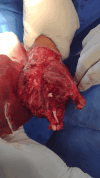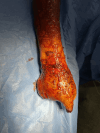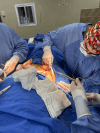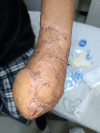Restorative Strategies for Bilateral Mutilated Hands in a Secondary Care Level: A Report of a Case in Mexico
- PMID: 38606221
- PMCID: PMC11008761
- DOI: 10.7759/cureus.56036
Restorative Strategies for Bilateral Mutilated Hands in a Secondary Care Level: A Report of a Case in Mexico
Abstract
This case report aims to delineate the challenges and management strategies for a patient with bilateral mutilated hands within a secondary care level in Mexico, contributing to medical literature and potentially guiding future patient care. Mutilated hands represent a significant surgical and rehabilitative challenge due to the profound structural damage they cause, leading to considerable functional impairment and psychological distress. The complexity of these injuries necessitates a multidisciplinary approach, particularly in resource-constrained settings. We present a case of a 45-year-old male with no prior significant medical history who sustained bilateral mutilated hands from an industrial accident involving hot rollers. The patient underwent extensive surgical reconstruction and postoperative care, facing complications such as skin graft integration issues and infections, which required a multidisciplinary treatment approach.
Keywords: complex trauma; general trauma surgery; hand and cosmetic surgeon; hand surgeon; plastic and reconstructive surgery.
Copyright © 2024, Aleman Paredes et al.
Conflict of interest statement
The authors have declared that no competing interests exist.
Figures












References
-
- Mutilated hand injuries. Hegge T, Neumeister MW. Clin Plast Surg. 2011;38:543–550. - PubMed
-
- Rondinelli RD, Genovese E, Katz RT, et al. AMA Guides to the Evaluation of Permanent Impairment, 6th Edition. Chicago, IL: American Medical Association; 2008.
-
- Managing mutilating hand injuries. Lahiri A. Clin Plast Surg. 2019;46:351–357. - PubMed
-
- The "Tic-Tac-Toe" classification system for mutilating injuries of the hand. Weinzweig J, Weinzweig N. Plast Reconstr Surg. 1997;100:1200–1211. - PubMed
Publication types
LinkOut - more resources
Full Text Sources
